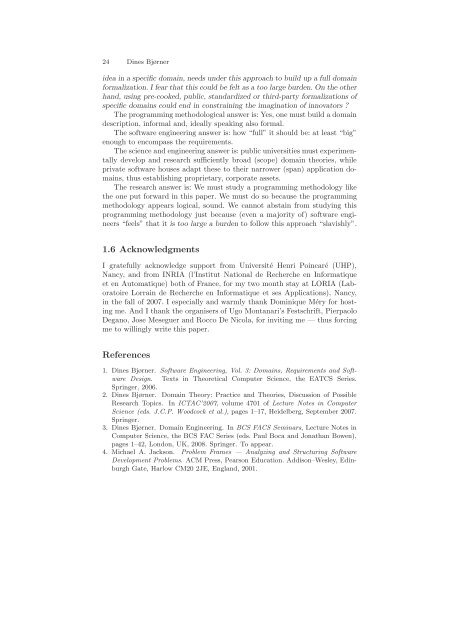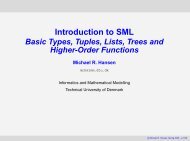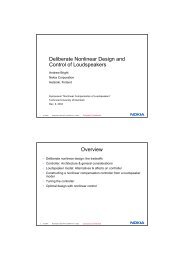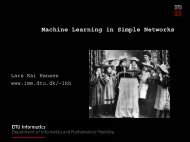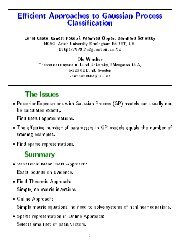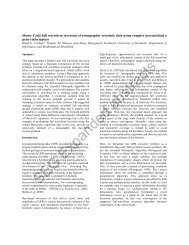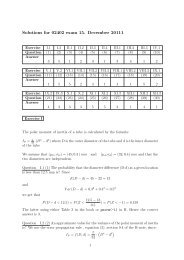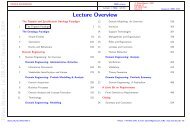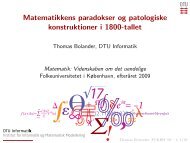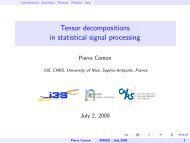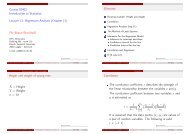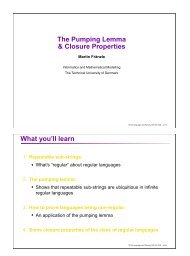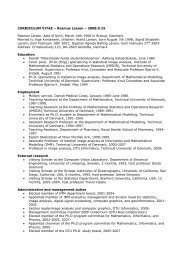the Ugo Montanari Festschrift paper - DTU Informatics
the Ugo Montanari Festschrift paper - DTU Informatics
the Ugo Montanari Festschrift paper - DTU Informatics
You also want an ePaper? Increase the reach of your titles
YUMPU automatically turns print PDFs into web optimized ePapers that Google loves.
24 Dines Bjørner<br />
idea in a specific domain, needs under this approach to build up a full domain<br />
formalization. I fear that this could be felt as a too large burden. On <strong>the</strong> o<strong>the</strong>r<br />
hand, using pre-cooked, public, standardized or third-party formalizations of<br />
specific domains could end in constraining <strong>the</strong> imagination of innovators ?<br />
The programming methodological answer is: Yes, one must build a domain<br />
description, informal and, ideally speaking also formal.<br />
The software engineering answer is: how “full” it should be: at least “big”<br />
enough to encompass <strong>the</strong> requirements.<br />
The science and engineering answer is: public universities must experimentally<br />
develop and research sufficiently broad (scope) domain <strong>the</strong>ories, while<br />
private software houses adapt <strong>the</strong>se to <strong>the</strong>ir narrower (span) application domains,<br />
thus establishing proprietary, corporate assets.<br />
The research answer is: We must study a programming methodology like<br />
<strong>the</strong> one put forward in this <strong>paper</strong>. We must do so because <strong>the</strong> programming<br />
methodology appears logical, sound. We cannot abstain from studying this<br />
programming methodology just because (even a majority of) software engineers<br />
“feels” that it is too large a burden to follow this approach “slavishly”.<br />
1.6 Acknowledgments<br />
I gratefully acknowledge support from Université Henri Poincaré (UHP),<br />
Nancy, and from INRIA (l’Institut National de Recherche en Informatique<br />
et en Automatique) both of France, for my two month stay at LORIA (Laboratoire<br />
Lorrain de Recherche en Informatique et ses Applications), Nancy,<br />
in <strong>the</strong> fall of 2007. I especially and warmly thank Dominique Méry for hosting<br />
me. And I thank <strong>the</strong> organisers of <strong>Ugo</strong> <strong>Montanari</strong>’s <strong>Festschrift</strong>, Pierpaolo<br />
Degano, Jose Meseguer and Rocco De Nicola, for inviting me — thus forcing<br />
me to willingly write this <strong>paper</strong>.<br />
References<br />
1. Dines Bjørner. Software Engineering, Vol. 3: Domains, Requirements and Software<br />
Design. Texts in Theoretical Computer Science, <strong>the</strong> EATCS Series.<br />
Springer, 2006.<br />
2. Dines Bjørner. Domain Theory: Practice and Theories, Discussion of Possible<br />
Research Topics. In ICTAC’2007, volume 4701 of Lecture Notes in Computer<br />
Science (eds. J.C.P. Woodcock et al.), pages 1–17, Heidelberg, September 2007.<br />
Springer.<br />
3. Dines Bjørner. Domain Engineering. In BCS FACS Seminars, Lecture Notes in<br />
Computer Science, <strong>the</strong> BCS FAC Series (eds. Paul Boca and Jonathan Bowen),<br />
pages 1–42, London, UK, 2008. Springer. To appear.<br />
4. Michael A. Jackson. Problem Frames — Analyzing and Structuring Software<br />
Development Problems. ACM Press, Pearson Education. Addison–Wesley, Edinburgh<br />
Gate, Harlow CM20 2JE, England, 2001.


